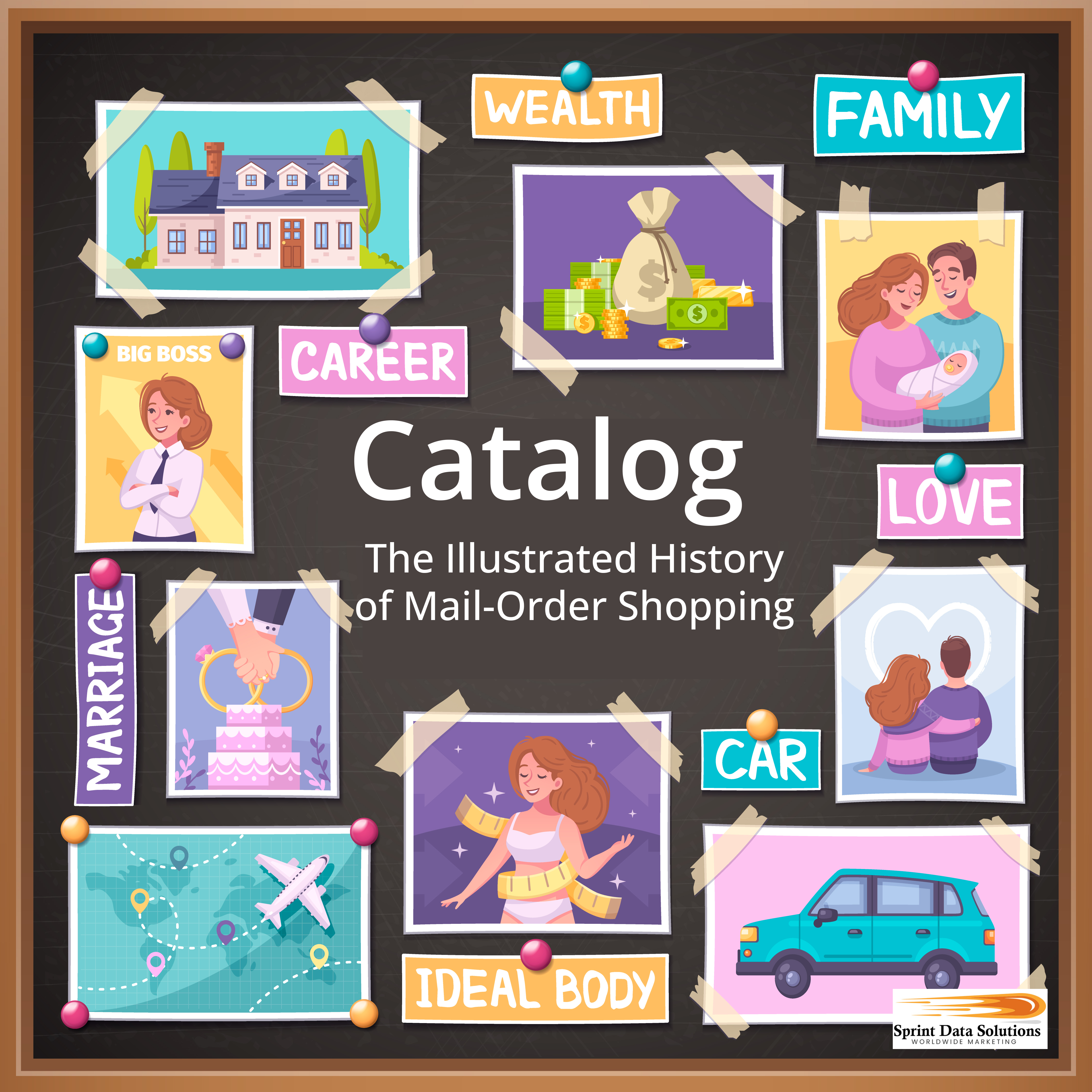Catalog & Magazine Mailing List
The 21st century has ushered in dramatic shifts in how people interact with the world around them, especially in the realm of commerce. Shopping, once a predictable, in-person experience involving visits to local markets, department stores, or sprawling shopping malls, has been transformed by the rise of digital technology. Today, consumers across the United States and around the world enjoy the unparalleled convenience of browsing and purchasing products from the comfort of their homes through e-commerce platforms. Despite this digital revolution, one traditional marketing tool has shown surprising resilience and adaptability—the catalog. Once a staple of American households, the catalog continues to occupy a meaningful role in modern retail, whether in its classic printed format or as a digital PDF or interactive flipbook.
Catalogs serve more than a nostalgic function; they remain an effective organizational and promotional tool, guiding consumers through curated selections of products in a structured and visually engaging way. They bridge the gap between discovery and decision-making, offering tangible browsing experiences that digital ads often lack. Moreover, catalogs have heavily influenced the architecture of e-commerce websites, which now mimic catalog layouts to improve user navigation and product exploration. When combined with magazines and direct mail, catalogs form a powerful trio in multichannel marketing strategies, reaching audiences that may not respond as effectively to purely digital outreach. For businesses aiming to tap into this enduring and versatile marketing channel, Sprint Data Solutions Worldwide Marketing offers targeted expertise. With years of experience in catalog and magazine outreach, Sprint provides tailored campaigns that help clients connect meaningfully with both legacy and modern consumers across demographic boundaries.
The Sprint Data Solutions Worldwide Marketing Story
Sprint Data Solutions Worldwide Marketing is a proudly American-owned and operated business founded by a disabled veteran. After completing a distinguished period of service to the nation, the founder envisioned a new chapter focused not on defense, but on economic contribution—specifically, fostering growth within the American business ecosystem. This vision materialized in the form of Sprint Data Solutions Worldwide Marketing, which set down its roots in the entrepreneurial heartland of Las Vegas, Nevada. From its inception, the company has been driven by a commitment to empower businesses through innovative marketing strategies, anchored in a deep understanding of both traditional and modern techniques. Today, the leadership team draws upon more than 50 years of combined expertise in marketing, advertising, and sales, creating a foundation of strategic insight and industry acumen.
In its early days, the company operated in a marketing landscape still dominated by analog approaches—where print, television, and radio were the primary mediums for reaching consumers. Sprint Data Solutions chose to establish itself in one of the most tangible and measurable marketing disciplines: direct mail. Specializing in customized print campaigns, the company quickly developed a reputation for delivering effective and targeted marketing solutions. Direct mail proved resilient over time, maintaining its relevance even in the face of digital disruption. It remains a cornerstone of the company’s service offerings, valued for its personalized outreach and proven return on investment.
As client demand increased, so did the company’s ambitions. What began as a local endeavor in Las Vegas rapidly expanded to encompass the entire state of Nevada, then spread across the contiguous United States. Soon after, Sprint Data Solutions extended its reach to include Hawaii and Alaska, offering true nationwide coverage. The company then took its services to the next level by scaling across borders, first establishing operations in Canada and Mexico, and later crossing the Atlantic to serve businesses looking to tap into the lucrative European Union markets, including France. This expansion was driven not just by ambition, but by a consistent track record of results and a dedication to customer success.
While direct mail remains an essential offering, the evolution of technology and the rise of digital platforms prompted Sprint Data Solutions to adapt and grow. Embracing change, the company introduced a robust suite of digital marketing services to complement its traditional ones. These include email campaigns, online lead generation, SEO strategies, and data-driven advertising models tailored to the dynamic behaviors of modern consumers. This hybrid approach ensures that clients can leverage both the reliability of direct mail and the precision of digital analytics for optimal market penetration and engagement.
Today, Sprint Data Solutions Worldwide Marketing stands as a comprehensive marketing partner for businesses at every level—from local startups to multinational enterprises—offering them the tools, experience, and vision needed to achieve sustainable growth in an increasingly competitive environment.

The Catalog & Magazine Advantage
Despite the rise of digital commerce, printed catalogs and magazines continue to hold a distinctive place in the marketing ecosystem, not merely as nostalgic artifacts but as strategically valuable tools—especially when crafted with care and quality. Their physicality imparts a sense of tangibility and permanence that online formats often lack. In fact, rather than being rendered obsolete by online ordering systems, catalogs have evolved into complementary channels that can stimulate interest and engagement offline before transitioning the consumer to digital purchasing. Historically, catalog shopping involved more logistical effort—customers would browse offerings in a printed booklet, then either visit a brick-and-mortar store, complete a mail-order form, or place a phone call to make a purchase. These methods, while slower, often fostered a more deliberate and immersive shopping experience.
Magazines, likewise, possess a tactile appeal and visual richness that websites rarely achieve. A well-curated magazine benefits from the skill of professional editors, designers, and photographers, often resulting in higher production values than many quickly-assembled digital pages. Furthermore, magazines do not rely on internet access, making them accessible in a variety of environments—be it a coffee table, waiting room, or airplane. This independence from connectivity makes them a unique vehicle for uninterrupted brand messaging and storytelling.
For businesses, both catalogs and magazines offer the opportunity to break through the noise of crowded email inboxes and social media feeds. These print formats enable brands to deliver a memorable, sensorial experience that invites deeper engagement. Once readers are ready to act—enticed by striking visuals or compelling content—they can easily use modern tools like smartphones or laptops to place an order through a website or app, or revert to traditional methods like a customer service hotline. This hybrid approach is particularly effective for industries where product discovery benefits from curated presentation, such as home decor, luxury goods, fashion, or gourmet food. In short, when used strategically, catalogs and magazines enhance digital marketing rather than compete with it, offering a balanced blend of inspiration and convenience.
Home Cooking Magazines
The COVID-19 pandemic significantly reshaped daily habits, especially around dining. With lockdowns and health concerns, people turned to home-cooked meals out of necessity, and that behavior has persisted even as restrictions eased. Today, many individuals continue to view cooking at home as not just a safer alternative, but also a more economical choice, particularly for those managing a monthly budget. Dining out regularly can quickly become costly, whereas preparing meals at home allows for better control over ingredients, portion sizes, and spending. In this renewed interest in home cooking, traditional print resources like cooking magazines have regained popularity. Unlike digital devices such as phones or tablets, which can be cumbersome or prone to damage in a kitchen environment, magazines offer a tactile, distraction-free experience. They also provide curated recipes, expert tips, seasonal meal ideas, and culinary inspiration in a format that’s both visually appealing and durable, making them a preferred companion for both amateur cooks and seasoned food enthusiasts.
Fine Wines
Wine is more than just a beverage—it represents a lifestyle, a tradition, and in many cases, a refined pursuit of taste and knowledge. For enthusiasts, wine can be a personal journey, a collectible asset, or even a strategic investment. Because of its deep cultural roots and centuries-long heritage, wine holds a unique place in the world of leisure and luxury. This is why wine magazines and catalogs continue to hold strong appeal within the wine community. They offer not only a platform to showcase products but also serve as vital resources for education, storytelling, and engagement.
Effective wine marketing acknowledges the wide spectrum of consumers, ranging from casual drinkers of affordable table wines to collectors seeking rare vintages from prestigious vineyards. Some wines are everyday staples, while others are reserved for celebratory moments, such as late-harvest or ice wines. Each type appeals to a different emotional and economic tier. Thus, content in wine publications must go beyond glossy images—it should offer rich, authoritative commentary on tasting notes, terroir, winemaking techniques, vintage reports, food pairings, and industry news. Additionally, narratives about winemakers, regions, and historical influences help cultivate appreciation and sophistication among readers.
Magazines dedicated to wine can adopt diverse editorial angles: some may focus on the science of viticulture, others on the art of sommelier expertise or the lifestyle of wine tourism. Trends such as organic and biodynamic wine production, climate change’s impact on grape harvests, and emerging wine regions also provide contemporary relevance. In essence, a successful wine publication weaves together the threads of tradition, innovation, and sensory pleasure to fully engage its audience—whether they are hobbyists, connoisseurs, or collectors.

Cigars
Cigars, much like fine wine, are widely regarded as premium indulgences that symbolize sophistication and leisurely enjoyment. They carry a deep cultural legacy, with roots that stretch back through centuries of tradition, connoisseurship, and ceremony. Unlike cigarettes, which are often consumed out of habit or addiction, cigars are typically enjoyed more sparingly—reserved for special moments or social rituals, enhancing their status as luxury items. The appreciation of cigars involves a developed palate and a deeper sensory engagement, making them an acquired taste for many enthusiasts.
As consumables, cigars share another trait with wine: they offer an ongoing opportunity for exploration and replenishment. Once a box or selection is finished, aficionados often look forward to trying something new—whether it’s a different blend, origin, or brand. This opens the door for both repeat purchases and brand experimentation. Effective presentation and marketing, particularly when paired with storytelling, tasting notes, or educational content about the origin, craftsmanship, and pairing possibilities, can significantly enhance appeal. For producers and retailers, tapping into the experiential and aspirational elements of cigar smoking can drive engagement and build brand loyalty—especially when targeted at discerning, high-end consumer segments.
Household Goods
Homes depend on a wide array of essential products to function effectively and comfortably. From cleaning supplies like dishwashing detergent and laundry soap to hygiene necessities such as toilet paper and personal care items, each room in a household demands its own set of tools and resources. Seasonal items—such as salt for icy sidewalks in winter or pest control products in summer—further add to the list of requirements. Comprehensive catalogs are valuable for presenting a curated selection of these items, offering both common staples and specialty products, while home-focused magazines provide expert insights, reviews, and comparisons. These publications often include advice on best practices, sustainability tips, and DIY maintenance techniques that help homeowners make informed decisions. Together, catalogs and magazines not only guide purchasing decisions but also support efficient, safe, and comfortable household management.
Children’s Products
The market for children’s products continues to flourish, encompassing a vast array of offerings that span educational tools, developmental services, health and nutrition items, toys, games, and digital entertainment. With such breadth, catalogs targeting this demographic must be just as varied and thoughtfully curated. In this dynamic space, children’s magazines stand out as particularly effective mediums. These publications not only entertain and educate young readers but also serve as trusted channels through which parents discover innovative products, parenting tips, and expert insights. Given that caregivers are continually seeking solutions to enhance their children’s growth and well-being, magazines tailored for young audiences become invaluable, offering a curated gateway to new ideas that elevate the child-rearing experience.
CBD Oil & CBD Creams
As the legal landscape around cannabis continues to evolve across the United States, cannabidiol (CBD)—a non-intoxicating compound derived from the cannabis plant—has gained significant traction as a therapeutic option for a variety of conditions affecting both humans and animals. Unlike THC, the psychoactive component of cannabis, CBD does not induce a “high,” making it more broadly appealing and legally acceptable in many jurisdictions. CBD oil is now widely recognized for its ability to alleviate stress, relieve chronic pain, reduce inflammation, and support digestive health, leading to a surge in product innovation and consumer interest.
Given its versatility and non-psychoactive nature, CBD has found a place in both editorial and direct-response formats, such as magazine features and product catalogs. These platforms can effectively educate potential consumers while promoting specific CBD products tailored to their needs. Marketing strategies must consider the diversity of the CBD user base. For example, older adults often turn to CBD oil for arthritis or joint pain relief, seeking a natural alternative to pharmaceuticals with fewer side effects. In contrast, athletes and fitness enthusiasts may prefer fast-absorbing topical CBD creams to manage muscle soreness and accelerate recovery times post-workout. Understanding these distinct consumer profiles is essential for crafting targeted messaging, optimizing product placement, and ensuring regulatory compliance, particularly in an industry that continues to be shaped by shifting legal and scientific developments.
Sports Magazines & Products
Sports have long inspired the creation of dedicated magazines that offer in-depth coverage of games, athletes, strategies, and events across various disciplines. This demand remains strong, fueled by a passionate audience seeking comprehensive insights—whether it’s for globally followed sports like soccer and basketball or more specialized pursuits such as fencing, curling, or bobsledding. These publications not only serve to inform but also to foster community and fan engagement through player interviews, behind-the-scenes analysis, historical retrospectives, and expert commentary.
In tandem with this content-driven interest, there is a consistent and growing need for sporting goods and related merchandise. Magazines that focus on gear—whether through feature articles, expert reviews, or expansive product catalogs—play a crucial role in connecting enthusiasts with the tools they need. From tennis rackets tailored for spin control to ski boots built for alpine speed, the success of these publications lies in effectively aligning the right products with the right sport and audience. When a publication successfully identifies and targets its niche—through well-researched editorial content and strategically curated advertising—it becomes an invaluable resource for athletes, hobbyists, and retailers alike.
Seeds & Plants
Gardening has long been a cherished aspect of American home life, offering not only a relaxing hobby but also a way to enhance the beauty and productivity of home environments. In recent years, the growing awareness around environmental sustainability, the push toward self-sufficiency, and the economic benefits of growing one’s own food have reignited widespread interest in gardening. Seeds and plants are now in high demand across all skill levels—from beginners starting with easy-to-grow herbs and vegetables to seasoned horticulturists seeking rare plant varieties, heirloom seeds, and advanced cultivation methods like hydroponics or permaculture. This resurgence opens up a broad market for a variety of products and services, including seed kits, organic fertilizers, smart gardening tools, subscription-based seed deliveries, and instructional content tailored to various climates and experience levels. As gardening continues to evolve from a pastime into a lifestyle choice, the demand for both traditional and innovative solutions in this sector is set to grow even further.
Collectibles
Collectibles represent a massive and highly segmented niche within the broader consumer market, characterized by deep passion but divergent interests. Each category of collectible—be it stamps, vinyl records, retro video games, trading cards, or antique toys—attracts a distinct type of collector, each with unique preferences, behaviors, and spending habits. For instance, a stamp collector often values historical significance, rarity, and postal context, whereas a vinyl record enthusiast prioritizes audio fidelity, album artwork, and musical genre. In contrast, retro gamers focus on preserving and experiencing classic video game consoles, cartridges, and accessories from past decades, driven by nostalgia and historical appreciation for the evolution of gaming.
Because of this diversity, marketing materials such as catalogs, magazines, and newsletters must be crafted with precision and specificity. A generic collectibles catalog is unlikely to yield meaningful engagement across these vastly different collector communities. A retro gamer will have no interest in stamp-related content, just as a vinyl record aficionado may disregard an article on vintage video game accessories. The key to successful engagement lies in relevance: when marketing content is tailored to match the exact interests of a collector segment, response rates soar. These audiences are not only more likely to consume the content but are also more inclined to make purchases, share with peers, and remain loyal to the brand delivering these targeted experiences. In short, while the collectibles market is broad, its success hinges on niche specialization and strategic alignment between content and collector.

Clothing & Fashion
Clothing continues to be a cornerstone of consumer purchases, maintaining a dominant presence in both traditional mail order catalogs and the ever-expanding digital marketplace. This enduring appeal stems from clothing’s universal relevance and its ability to cater to diverse tastes, lifestyles, and functional needs. Sprint Data Catalog Mail Order buyers and RESPONDERS who enjoy shopping frequently gravitate toward apparel offerings not only for aesthetic reasons but also for practicality and lifestyle alignment. While casual and fashion-forward pieces remain popular, there is also a significant demand for professional and utilitarian garments. These items are often chosen for their resilience, comfort, and suitability to specific environments, such as workplaces or outdoor conditions, where functionality can outweigh current fashion trends.
Crucial to the success of clothing sales, particularly in catalog and magazine formats, is the quality of visual presentation. High-resolution, professionally staged photography significantly boosts the appeal of apparel by allowing consumers to visualize fit, texture, and use-case scenarios. Strategic investment in compelling imagery can dramatically increase buyer engagement, often turning interest into action. When combined with well-crafted descriptive content that highlights the clothing’s features, benefits, and potential applications—be it for fashion, protection, or performance—the result is a powerful marketing approach that consistently drives sales. In essence, while clothing preferences evolve with time and context, the fundamentals of strong presentation and storytelling remain timeless drivers of success in the apparel segment.
Home Improvement
Home improvement remains a dynamic and ever-growing industry, driven by both professional renovations and the enduring popularity of the “Do It Yourself” (DIY) movement. While hiring experienced contractors often yields polished and efficient results, it also requires a considerable financial commitment. This is one of the main reasons why many homeowners opt for DIY solutions—allowing them to control costs, personalize their space, and take pride in hands-on accomplishments. For businesses that supply home improvement tools, materials, or related services, tapping into this consumer segment presents a valuable opportunity. Reaching homeowners directly through targeted marketing campaigns can be especially rewarding, as these consumers are frequently looking for ways to enhance their properties.
From small repairs like replacing fixtures or repainting walls to major undertakings such as full kitchen remodels, basement conversions, or structural reinforcements, the scope of home improvement is vast. Some projects aim to boost comfort and functionality, while others are investments meant to increase property value. As trends evolve, homeowners often look to upgrade spaces with eco-friendly materials, smart home technologies, and modern aesthetics. The continuous demand for improvement—whether by necessity or design inspiration—makes the sector ripe for marketing innovation. Companies that can effectively position their offerings as essential tools in a homeowner’s DIY or renovation journey stand to benefit significantly in this competitive marketplace.
Precision Marketing
A fundamental key to success in traditional print marketing—whether through catalogs, magazines, or direct mail—lies in setting and striving toward a realistic response rate. While the allure of a high response rate is tempting, the notion of achieving a 100% return is impractical. Regardless of how attractive the design or compelling the message, not every recipient will be a suitable or interested buyer. However, businesses can greatly improve the odds of a meaningful response by adopting a strategic and data-informed approach.
One of the most common pitfalls is the temptation to take a broad, indiscriminate approach. For instance, purchasing a massive mailing list containing hundreds of thousands of names and addresses may create the illusion of reach and potential. But sheer volume does not equate to success. If the recipients are largely irrelevant to the product or service being marketed—such as sending a children’s toy catalog to a database dominated by single, childless college students—the inevitable result will be poor engagement and a waste of resources. The mismatch between offer and audience ensures that the message is disregarded.
The better strategy is to focus on precision marketing. Targeting a smaller, more refined audience that closely aligns with the product’s appeal increases the likelihood of interaction and conversion. Consider a company promoting educational toys for children aged 2 to 10. A curated list of just 5,000 verified families with children in that age bracket is likely to produce far superior results than a general list of 100,000 names with uncertain or unrelated demographics. This is because relevance drives response. The more a recipient sees a product or offer that fits their current needs or desires, the more inclined they are to act.
Data quality, segmentation, and message customization play a crucial role in this process. Leveraging reliable consumer data to target age, lifestyle, household composition, and buying behavior allows marketers to craft campaigns that resonate personally with recipients. Furthermore, reinforcing the offer with tangible benefits—such as discounts, free trials, or exclusive products—can heighten interest and urgency, encouraging immediate responses.
Ultimately, success in print marketing isn’t measured by how many people see the offer, but by how many of the right people are reached and motivated to respond. In marketing, as in many things, less can truly be more—if that “less” is a carefully chosen audience with a genuine need. Precision targeting not only increases the return on investment but also builds brand loyalty and trust among consumers who feel understood and valued.
We’re Here To Help
Over the years, Sprint Data Solutions Worldwide Marketing has built and continuously refined one of the most comprehensive and diverse databases serving both consumer and B2B markets. This depth of information has proven invaluable for organizations looking to execute highly targeted and efficient marketing campaigns. The company’s dedication to accuracy and relevancy is evident in its rigorous data hygiene practices. These measures significantly reduce the chances of wasted outreach efforts, such as contacting deceased individuals or sending specialized offers to recipients no longer interested or improperly matched by location or interest.
In today’s rapidly evolving communication landscape, having up-to-date contact information is no longer a luxury—it’s a necessity. Sprint Data Solutions recognizes that effective marketing requires a multi-channel approach. Accordingly, the company has expanded beyond traditional mailing addresses to embrace a wide array of contact points. This includes home and mobile phone numbers for voice calls, email addresses for digital campaigns, and cellular numbers for SMS/text message marketing. Such diversification ensures that campaigns can be tailored to consumer preferences, increasing engagement and conversion rates. With this level of detail and flexibility, Sprint Data Solutions continues to empower clients to reach their audiences more precisely and effectively than ever before.
Find The Right List For You
Whether you’re seeking a mailing list of catalog and magazine buyers, catalog shoppers, or mail-order consumers, Sprint Data Solutions Worldwide Marketing delivers highly targeted, high-quality data to support your direct marketing goals. Our databases are meticulously segmented and categorized to serve both consumer-focused and B2B campaigns, enabling marketers to execute finely tuned outreach strategies. Geographic customization is a standout feature—clients can launch broad, nationwide efforts or narrow their scope with precision targeting at the regional level, such as the New England area. We also support ultra-specific campaigns, down to individual states, cities, or even neighborhoods, making our lists ideal for hyperlocal advertising initiatives.
Our data resources go far beyond geographic filters. We maintain a robust inventory of demographic profiles built on a wide array of characteristics including age, gender, income level, purchasing behavior, and more. These databases are not static—they’re actively maintained and routinely validated to ensure up-to-date contact information and relevant targeting parameters. Sprint Data Solutions Worldwide Marketing integrates multiple data collection and verification strategies, combining proprietary research with industry-standard vetting techniques to deliver lists that maximize accuracy, engagement, and ROI for our clients.
- Age
- Ethnicity
- Debt
- Age of Children
- Renter
- Homeowner
- Income
- Marital Status
- Mortgage Data
- Geography
- Veteran Status
- Big & Tall Mail Order Buyers
With access to a vast array of data sources, Sprint Data Solutions Worldwide Marketing enables you to tailor your outreach with pinpoint accuracy—whether you’re targeting a broad demographic or a niche audience segment. We specialize in helping businesses reach the right consumers through expertly curated catalog and magazine direct mail lists. These lists are built to ensure that your print materials are delivered to recipients who are not only relevant but also responsive and more likely to convert. Whether you’re launching a nationwide campaign or a local promotion, our customized mailing lists can dramatically improve your return on investment. Trust Sprint Data Solutions to put your catalogs and magazines in the hands of the customers who matter most—because effective marketing starts with precision targeting.






